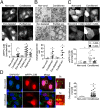Human placental trophoblasts confer viral resistance to recipient cells
- PMID: 23818581
- PMCID: PMC3718097
- DOI: 10.1073/pnas.1304718110
Human placental trophoblasts confer viral resistance to recipient cells
Abstract
Placental trophoblasts form the interface between the fetal and maternal environments and serve to limit the maternal-fetal spread of viruses. Here we show that cultured primary human placental trophoblasts are highly resistant to infection by a number of viruses and, importantly, confer this resistance to nonplacental recipient cells by exosome-mediated delivery of specific microRNAs (miRNAs). We show that miRNA members of the chromosome 19 miRNA cluster, which are almost exclusively expressed in the human placenta, are packaged within trophoblast-derived exosomes and attenuate viral replication in recipient cells by the induction of autophagy. Together, our findings identify an unprecedented paracrine and/or systemic function of placental trophoblasts that uses exosome-mediated transfer of a unique set of placental-specific effector miRNAs to directly communicate with placental or maternal target cells and regulate their immunity to viral infections.
Keywords: C19MC; miR-517-3p; primary human trophoblasts.
Conflict of interest statement
Conflict of interest statement: C.B.C. and Y.S. are named inventors on a pending patent application describing the use of C19MC microRNAs as therapeutics.
Figures





Comment in
-
Autophagy as a broad antiviral at the placental interface.Autophagy. 2013 Dec;9(12):1905-7. doi: 10.4161/auto.26819. Epub 2013 Oct 16. Autophagy. 2013. PMID: 24145384 No abstract available.
References
-
- Ornoy A, Tenenbaum A. Pregnancy outcome following infections by coxsackie, echo, measles, mumps, hepatitis, polio and encephalitis viruses. Reprod Toxicol. 2006;21(4):446–457. - PubMed
-
- Euscher E, Davis J, Holzman I, Nuovo GJ. Coxsackie virus infection of the placenta associated with neurodevelopmental delays in the newborn. Obstet Gynecol. 2001;98(6):1019–1026. - PubMed
-
- Noguer-Dance M, et al. The primate-specific microRNA gene cluster (C19MC) is imprinted in the placenta. Hum Mol Genet. 2010;19(18):3566–3582. - PubMed
Publication types
MeSH terms
Substances
Grants and funding
- UL1 RR024153/RR/NCRR NIH HHS/United States
- R01-AI081759/AI/NIAID NIH HHS/United States
- R01 HD075665/HD/NICHD NIH HHS/United States
- R01-HD065893/HD/NICHD NIH HHS/United States
- R21 HD071707/HD/NICHD NIH HHS/United States
- UL1-TR000005/TR/NCATS NIH HHS/United States
- UL1 TR000005/TR/NCATS NIH HHS/United States
- R01 AI081759/AI/NIAID NIH HHS/United States
- UL1-RR024153/RR/NCRR NIH HHS/United States
- R01 HD065893/HD/NICHD NIH HHS/United States
- R21-HD071707/HD/NICHD NIH HHS/United States
- R01-HD075665/HD/NICHD NIH HHS/United States
LinkOut - more resources
Full Text Sources
Other Literature Sources
Medical
Research Materials

